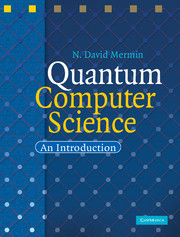Book contents
- Frontmatter
- Contents
- Preface
- A note on references
- 1 Cbits and Qbits
- 2 General features and some simple examples
- 3 Breaking RSA encryption
- 4 Searching with a quantum computer
- 5 Quantum error correction
- 6 Protocols that use just a few Qbits
- Appendices
- A Vector spaces: basic properties and Dirac notation
- B Structure of the general 1-Qbit unitary transformation
- C Structure of the general 1-Qbit state
- D Spooky action at a distance
- E Consistency of the generalized Born rule
- F Other aspects of Deutsch's problem
- G The probability of success in Simon's problem
- H One way to make a cNOT gate
- I A little elementary group theory
- J Some simple number theory
- K Period finding and continued fractions
- L Better estimates of success in period finding
- M Factoring and period finding
- N Shor's 9-Qbit error-correcting code
- O A circuit-diagrammatic treatment of the 7-Qbit code
- P On bit commitment
- Index
I - A little elementary group theory
from Appendices
Published online by Cambridge University Press: 05 June 2012
- Frontmatter
- Contents
- Preface
- A note on references
- 1 Cbits and Qbits
- 2 General features and some simple examples
- 3 Breaking RSA encryption
- 4 Searching with a quantum computer
- 5 Quantum error correction
- 6 Protocols that use just a few Qbits
- Appendices
- A Vector spaces: basic properties and Dirac notation
- B Structure of the general 1-Qbit unitary transformation
- C Structure of the general 1-Qbit state
- D Spooky action at a distance
- E Consistency of the generalized Born rule
- F Other aspects of Deutsch's problem
- G The probability of success in Simon's problem
- H One way to make a cNOT gate
- I A little elementary group theory
- J Some simple number theory
- K Period finding and continued fractions
- L Better estimates of success in period finding
- M Factoring and period finding
- N Shor's 9-Qbit error-correcting code
- O A circuit-diagrammatic treatment of the 7-Qbit code
- P On bit commitment
- Index
Summary
A set of positive integers less than N constitutes a group under multiplication modulo N if the set (a) contains 1, (b) contains the modulo-N inverse of any of its members, and (c) contains the the modulo-N products of all pairs of its members. A subset of a group meeting conditions (a)–(c) is called a subgroup. The number of members of a group is called the order of the group. An important result of the elementary theory of finite groups (Lagrang's theorem) is that the order of any of its subgroups is a divisor of the order of the group itself. This is established in the next three paragraphs.
If S is any subset of a group G (not necessarily a subgroup) and a is any member of G (which might or might not be in S), define aS (called a coset of S) to be the set of all members of G of the form g = as, where s is any member of S. (Throughout this appendix equality will be taken to mean equality modulo N.) Distinct members of S give rise to distinct members of aS, for if s and s′ are in S and as = as′, then multiplying both sides by the inverse of a gives s = s′. So any coset aS has the same number of members as S itself.
- Type
- Chapter
- Information
- Quantum Computer ScienceAn Introduction, pp. 193 - 194Publisher: Cambridge University PressPrint publication year: 2007



